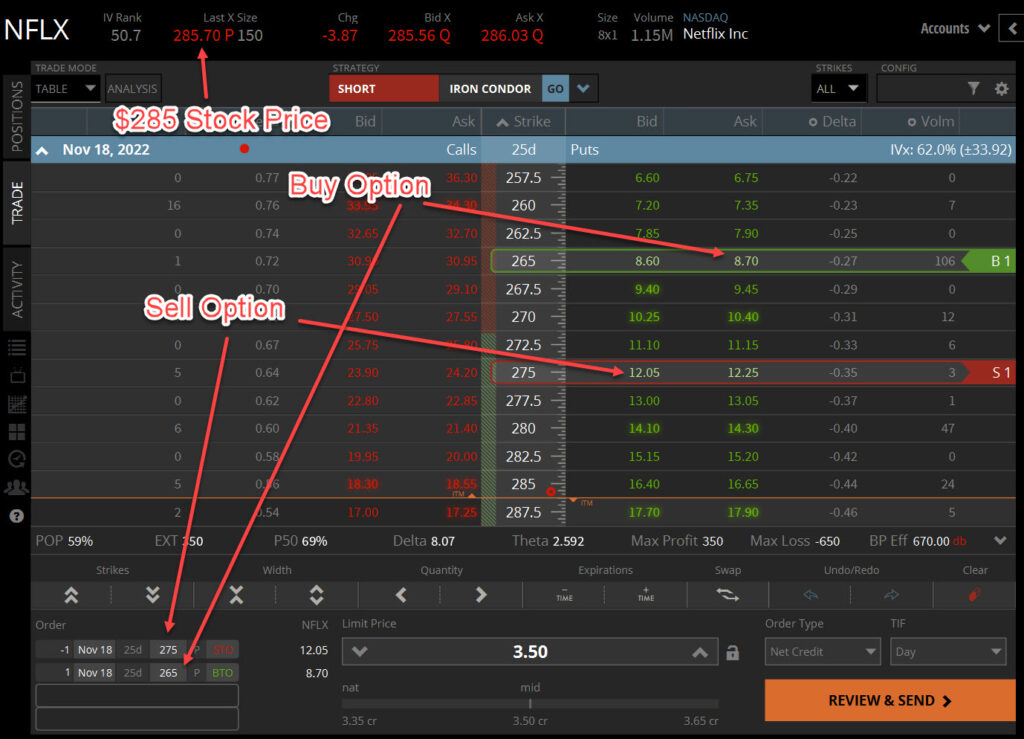If you’re looking for a way to make some extra money in your spare time, trading vertical option spreads might be the perfect solution for you. Vertical option spreads are a type of options strategy that allow traders to profit from price movements in either direction. In this post, we’ll discuss what vertical option spreads are, and how you can use them to generate profits in the markets. We’ll also take a look at some of the risks and rewards associated with trading vertical option spreads. So if you’re interested in learning more about this profitable trading strategy, keep reading!
We discuss:
- What is a vertical option spread?
- How do you sell a Vertical Spread?
- Max Profit
- Max Loss
- Breakeven
- The are the Advantages of Vertical Option Spreads?
Real quick guys, be sure and grab the FREE Simplified Options Strategies Trading Guide. It covers the different options strategies setups, how and when to put them on, max profits, and trade management. It’s a great guide to have by your side when trading options.
So let’s get started!
What is a Vertical Spread?
A Vertical Spread is the combination of a long option and a short option with different strike prices placed within the same expiration date. So when you trade a vertical spread you are effectively placing two trades at once.
There are two types of vertical spreads. Call Verticals and Put Verticals. We are going to focus only on selling vertical spreads (as opposed to buying them) since this is a much higher probability and we want to play the role of the casino versus that of the gambler. When we sell options we collect time premium.
We sell Call vertical spreads when we are neutral to bearish on a trade and we want the stock to come down in price.
We sell Put vertical spreads when we are neutral to bullish on a trade and want the stock to increase in price.
How do we sell a Vertical Spread?

Let’s look on the Tastyworks trade platform. I’ll put a link down below. It’s the best platform for trading options and if you use the link below you will get a special offer when you open an account.
So we will go to the Trade Tab and lets punch in the ticker NFLX. Netflix is down right now and it is a great stock long term and we think the price is going to go up. So we are going to sell a Vertical Put Spread. We look at the options chain that is 25 to 45 days out or DTE Days to Expiration.

With Netflix currently trading at $285, we sell the closer to the money put option (275) and we buy the further from the money option (265). We put this on in one trade and look to collect about 1/3 the width of the strikes in option premium.
So it is a $10 wide spread and we are collecting $3.50 or $350 on a $1000 wide spread for the 1 contract or 100 shares.
We hit review and send and place the trade.
How do we calculate Max Profit?
The max profit is the credit that we receive when we place the trade.

In the case of the NFLX trade, we collected $350. We keep this max profit as long as the stock price stays above the short strike price of $275 at expiration.
How do we calculate Max Loss?
The max loss is the difference between the width of the strikes and the credit received. So in the NFLX trade we sold a $10 wide and spread and collected $3.50. Our max loss is $10-$3.50 or $6.50.

So you may ask why would we risk $650 to put on a trade that only has a max profit of $350 Max Profit?
It’s because it has roughly a 65% POP or probability of profit.
How do we calculate Breakeven?

The breakeven of a vertical spread is the short put strike minus the credit received. So in the NFLX example it would be the 275 – 3.50 or $271.5. So the stock price could drop down to the $271.5 price from the current price of 285 and we still breakeven. If it stays anywhere above that price we make money.
The Advantages of Vertical Option Spreads
Let’s take a look at some of the advantages selling vertical spreads.
First, we can choose our Probability of Profit. The probability of success is directly tied to the risks. So if we are super confident a stock will go up in price and want to collect a little more premium up front we may choose to only have only a 60% POP or probability of profit.
If we want to be more conservative, we can choose the 90% POP and be almost guaranteed to make a smaller profit.
I prefer to stay around 70-75% POP and collect a good premium up front.
Another advantage of selling vertical spreads is that we limit our risks. Since are buying the further out of the money option, no matter how far beyond the short strike the stock price moves, we have capped out max loss.
Lastly, vertical spreads allow us to use less buying power and trade larger stocks. Because we are capping our max loss, the broker does not require us to put up a lot of capital to make the trade. They know that we have a max loss and therefore we can cover the loss. This allows us to trade high priced stocks that would normally take a lot of capital to otherwise trade.
Alright guys, thanks for watching! Please remember to comment below. Keep an eye out for the next one as we discuss “must know” tips for managing vertical spreads for maximum profit.
Also, be sure and grab the FREE Simplified Options Strategies Trading Guide. I’ll put a link down below. It covers the different options strategies setups, how and when to put them on, max profits, and trade management. It’s a great guide to have by your side when trading options.
Happy trading and I’ll see you in the next one!
Are you trading vertical spreads? If so in what stocks and why?
Comments are closed.